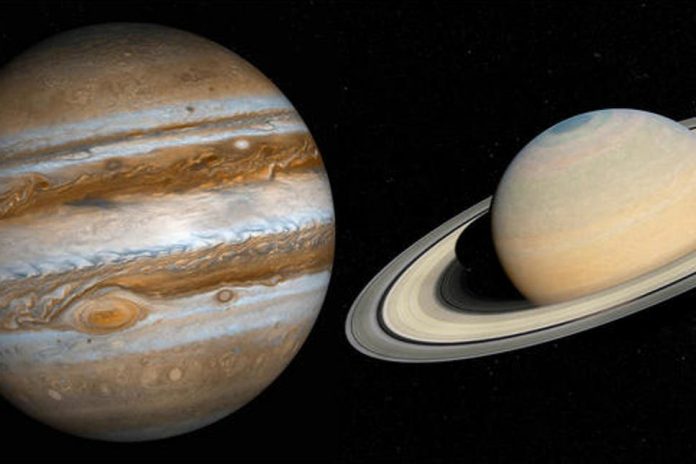Two giant worlds are about to collide. Sort of.
Jupiter and Saturn are meeting up this month. It’s something they do every 20 years, only this year the neighboring planets will appear closer to each other on the dome of our sky than at any point since the Middle Ages.
Jupiter is already the brightest star-like object an Earthling can see in the evening sky. But on Dec. 21, Jupiter and Saturn are going to be so close together that they will show up as one intensely bright point of light forming what some refer to as the “Christmas Star” or “Star of Bethlehem.”
“Jupiter goes around the sun every 12 years. Saturn goes around every 30 years. What that means for us is when we look up in our sky, Jupiter and Saturn tag up. We call that a conjunction,” said Mike Hennessy, manager of the Carnegie Science Center’s Buhl Planetarium on Pittsburgh’s North Shore. “It’s when planets or other objects appear very close to one another. But this one is very special because it’s a great conjunction.”
So how can it be said these two planets will be “close,” when they will remain 403 million miles apart?
“They are closer together than usual out in space and they will appear close, together because of our perspective on Earth,” Hennessy said. “Since the summer, Saturn has been chasing Jupiter through the night sky, basically.
“You can think of it as two runners and Jupiter is on an inside track around the sun and Saturn is on an outside track. But they are at the points in their orbits where they are almost neck and neck now as they’re going around the sun. So, that’s the closest they would be to each other,” said Hennessy.
Here’s another way to think of it: Jupiter and Saturn will combine to form the optical equivalent of one-fifth of the diameter of the full moon in the night sky.
And Jupiter and Saturn will be so close that stargazers will be able to see them together through a telescope, according to Lou Coban, electronic technician/administrator of the University of Pittsburgh’s Allegheny Observatory. Coban said covid-19 concerns will prevent people from being allowed into the observatory but they’ll have the opportunity to see plenty from home.
“If you look at them with a modest telescope, even a small telescope or a pair of binoculars, you will be able to see two of the largest planets in the solar system in the same field of view of an eyepiece,” said Coban. “You should be able to see the rings of Saturn and the moons going around Jupiter.”
Hennessy said this is an especially good year for viewing Saturn’s rings.
“The rings of Saturn are actually extremely thin. They are on average only 30 feet thick, believe it or not,” said Hennessy. “Some years it’s tough to see the rings but this year you can. Saturn’s rings are going to be tilted toward Earth so that you can see the north face of the rings really well.”
Hennessy said the best time to view the conjunction on Dec. 21 is at twilight, between 5:30 and 6:30 p.m., looking southwest.
“I think it’s exciting because, for me, a celestial event like this is a reminder for folks to look up and enjoy the sky we all share,” said Hennessy. “It’s fun to think of looking at Jupiter and Saturn right now through a telescope, that we’re carrying on Galileo’s tradition.”
The next great conjunction won’t happen again until 2080, according to Coban.
“I like to tell people to put duct tape on their socks, because this is going to knock their socks off,” said Coban.





























